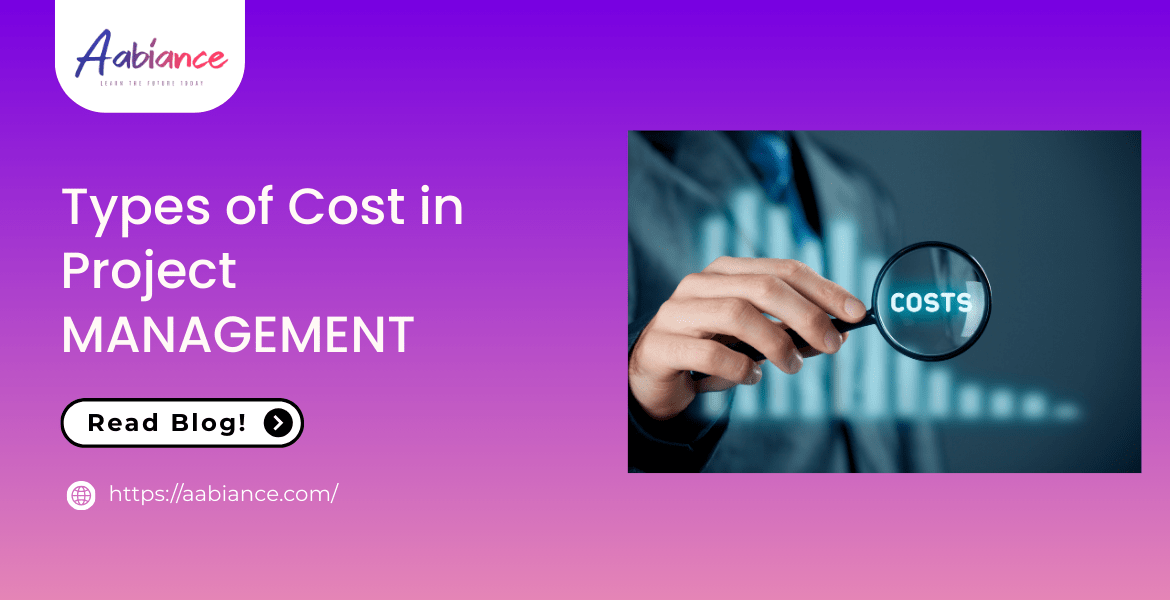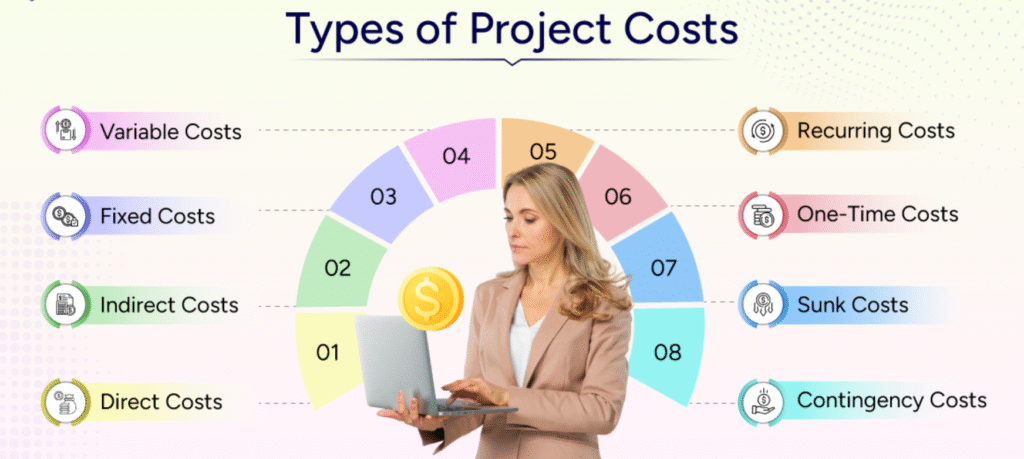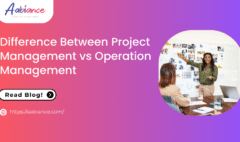Types of Cost in Project Management: A Complete Guide
August 4, 2025 2025-08-28 19:03Types of Cost in Project Management: A Complete Guide

Types of Cost in Project Management: A Complete Guide
Managing costs is one of the most important responsibilities in any project. Whether you’re leading a small IT development team or managing a large-scale construction project, understanding and controlling costs can mean the difference between success and failure. If you’re pursuing a Project Management Professional certification, you’ll quickly realize how essential cost management is to overall project success.
In this blog, we’ll explore the types of cost in project management, explain how they impact your budget and decisions, and connect them to real-world project management practices. If you’re preparing for your project management professional certification India or looking for the best online project management certificate, this guide will provide valuable insights to strengthen your foundation.

Why Understanding Project Costs Matters
Project costs are more than just money spent — they represent time, resources, effort, and value. Accurate cost estimation and control help you:
- Stay within budget
- Prevent financial risks
- Optimize resource usage
- Maintain stakeholder confidence
This is why project management professional training emphasizes cost management across all stages of a project. Let’s now dive into the different types of project costs and how they influence project decision-making.
Major Types of Cost in Project Management
- Fixed Costs
Fixed costs are expenses that remain constant throughout the project, regardless of activity levels or timelines.
Examples include:
- Office rent
- Software license fees
- Salaries of permanent staff
- Equipment lease agreements
Why it matters:
Fixed costs are predictable and help establish a baseline budget. When you’re taking the project management professional certification, you’ll learn how these costs affect your project’s financial stability.
- Variable Costs
Variable costs change based on project output or progress. The more work done, the higher the variable costs.
Examples include:
- Wages for temporary workers
- Cost of raw materials
- Utility bills (if usage increases with activity)
Why it matters:
Variable costs can spiral if not monitored carefully. Controlling them is crucial, especially in Agile environments where project scope can evolve.
- Direct Costs
Direct costs are expenses that can be directly linked to a specific project or activity.
Examples include:
- Contractor payments
- Equipment purchased for the project
- Travel expenses for team members
Why it matters:
Tracking direct costs helps in evaluating project profitability. Many case studies in product owner certification courses emphasize managing direct costs efficiently to deliver customer value.
- Indirect Costs
Indirect costs are not tied to one specific task or project but are necessary for general operations.
Examples include:
- Administrative salaries
- Office utilities
- Insurance and legal expenses
Why it matters:
Understanding indirect costs is vital for full cost accounting. During your project management professional certification India training, you’ll learn how to allocate indirect costs fairly across multiple projects.
- Sunk Costs
Sunk costs are costs that have already been incurred and cannot be recovered, regardless of future project decisions.
Examples include:
- Money spent on failed prototypes
- Deposits for canceled contracts
- Previous R&D investments
Why it matters:
Many inexperienced managers fall into the “sunk cost fallacy” — continuing a failing project just because of past investment. As a project management professional, you must learn to evaluate projects based on future value, not past spending.
- Opportunity Costs
Opportunity cost is the value of the best alternative that you forego when choosing one option over another.
Example:
Choosing Project A over Project B means losing the potential profit from Project B.
Why it matters:
This type of cost is abstract but critical. Strategic project decisions — a core part of the best online project management certificate programs — often hinge on opportunity cost analysis.
- Recurring Costs
Recurring costs are repeated at regular intervals during the project lifecycle.
Examples include:
- Monthly software subscriptions
- Salaries of ongoing consultants
- Maintenance costs
Why it matters:
Recurring costs affect cash flow. Understanding them ensures the organization remains financially healthy throughout the project timeline.
- Non-Recurring Costs
Non-recurring costs are one-time expenses that don’t repeat during the project.
Examples include:
- One-time training fees
- Initial hardware purchases
- Setup or installation costs
Why it matters:
These are upfront investments. Calculating them accurately is crucial for initial project budgeting and ROI estimation.
- Contingency Costs
Contingency costs are reserved funds to cover unexpected expenses or risks.
Examples include:
- Emergency repairs
- Resource replacements
- Delay penalties
Why it matters:
A skilled project management professional always includes a contingency buffer. In your PMP training, you’ll learn how to estimate risk reserves to protect project goals.
How Cost Types Are Used in Project Planning
Cost types aren’t just definitions — they’re tools used across planning, execution, and closing stages.
Here’s how:
- During planning:
You’ll use fixed, variable, direct, and indirect costs to build a cost baseline and create a budget. - During execution:
You’ll monitor recurring and variable costs, adjust resource use, and track actual vs. estimated spending. - During closing:
You’ll assess total costs, including sunk and opportunity costs, to measure ROI and organizational impact.
Whether you’re earning your product owner certification or managing Agile sprints, cost awareness helps prioritize work and value delivery.
Cost Management and PMP Certification
If you’re preparing for the project management professional certification, cost management is a key area in the PMBOK® Guide (Project Management Body of Knowledge). You’ll be expected to understand and apply:
- Cost estimating techniques
- Budgeting tools
- Earned Value Management (EVM)
- Cost control strategies
Top PMP training programs—especially those considered the best online project management certificate courses—teach you how to analyze all types of project costs effectively.
In India, the demand for certified project managers continues to grow. More companies are investing in professionals with the project management professional certification India as they help organizations control costs, minimize waste, and maximize profit.
Common Cost Management Mistakes to Avoid
Here are some cost-related pitfalls project managers should avoid:
- Ignoring indirect or hidden costs
- Not updating budgets regularly
- Overlooking contingency reserves
- Falling into the sunk cost trap
- Underestimating opportunity costs
Avoiding these errors is part of becoming a competent project management professional. With proper training and experience, you’ll develop the judgment needed to handle project finances like a pro.
Conclusion
Cost management is not just about numbers—it’s about making smarter decisions, delivering value, and achieving business goals. Understanding the types of cost in project management helps you:
- Create realistic budgets
- Avoid financial pitfalls
- Allocate resources wisely
- Improve project success rates
Whether you’re pursuing a project management professional certification, planning to enroll in the best online project management certificate, or preparing for a product owner certification, mastering cost types will give you a competitive edge.
In fast-growing markets like India, gaining your project management professional certification India opens doors to high-impact roles in IT, construction, healthcare, finance, and more. And with financial clarity being a top priority in every industry, cost management skills will always be in demand.
Master project cost types and ace your PMP certification—start learning today!
Project costs are classified into categories like fixed, variable, direct, indirect, sunk, opportunity, recurring, non-recurring, and contingency costs. Each type serves a specific role in budgeting, monitoring, and decision-making.
Knowing the different cost types helps project managers create accurate budgets, allocate resources wisely, forecast expenses, and make informed decisions—leading to better project success rates.
- Fixed costs remain the same regardless of project activity (e.g., office rent, permanent salaries).
- Variable costs change depending on the project’s progress or output (e.g., raw materials, temporary labor).
Opportunity cost measures the value of the best alternative you give up when choosing one project over another. It’s a critical factor in strategic decision-making, especially when resources are limited.
Yes. Project Management Professional (PMP) certification includes cost management as a core topic, teaching techniques like cost estimation, budgeting, earned value management (EVM), and cost control strategies.







